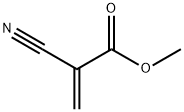|
|
| | CYANOACRYLIC ACID METHYL ESTER Basic information |
| Product Name: | CYANOACRYLIC ACID METHYL ESTER | | Synonyms: | CA-7【adhesive】;Cemedine-3000 Type-11;2-CYANOMETHYLACRYLATE;methyl 2-cyanoprop-2-enoate;2-cyano-2-propenoicacidmethylester;2-cyano-2-propenoicacimethylester;alpha-Cyanoacrylic acid, methyl ester;alpha-cyanoacrylicacidmethylester | | CAS: | 137-05-3 | | MF: | C5H5NO2 | | MW: | 111.1 | | EINECS: | 205-275-2 | | Product Categories: | Organics | | Mol File: | 137-05-3.mol |  |
| | CYANOACRYLIC ACID METHYL ESTER Chemical Properties |
| Melting point | -40 °C | | Boiling point | bp 48-49° | | density | nD25 1.443. d20 1.1044 | | vapor pressure | 49hPa at 20℃ | | refractive index | n20D 1.4459 | | form | Colorless liquid | | LogP | 0.24 at 25℃ and pH7 | | EPA Substance Registry System | Methyl 2-cyanoacrylate (137-05-3) |
| Hazard Codes | Xi | | Risk Statements | 36/37/38 | | Safety Statements | 23-24/25-26 | | Hazardous Substances Data | 137-05-3(Hazardous Substances Data) | | Toxicity | guinea pig,LD50,skin,> 10959mg/kg (10959mg/kg),"Documentation of the Threshold Limit Values and Biological Exposure Indices," 5th ed., Cincinnati, OH, American Conference of Governmental Industrial Hygienists, Inc., 1986Vol. 6, Pg. 965, 1991. |
| | CYANOACRYLIC ACID METHYL ESTER Usage And Synthesis |
| Description | Methyl cyanoacrylate (MCA) is an organic compound that contains several functional groups, a methyl ester, a nitrile, and an alkene. It is a colorless liquid with low viscosity. Its chief use is as the main component of cyanoacrylate glues.It can be encountered under many trade names. Methyl cyanoacrylate is less commonly encountered than ethyl cyanoacrylate.
It is soluble in acetone, methyl ethyl ketone, nitro methane, and dichloromethane. MCA polymerizes rapidly in presence of moisture. | | Chemical Properties | Methyl cyanoacrylate is a thick, clear liquid
adhesive. The odor threshold is 2.2 ppm. | | Chemical Properties | Colorless liquid. | | Uses | Surgical aid (tissue adhesive). | | Uses | In high-bond strength, fast-acting
glues (e.g., Krazy Glue); surgical use as tissue
adhesive | | General Description | Clear slightly yellow liquid. | | Air & Water Reactions | Insoluble in water. | | Reactivity Profile | CYANOACRYLIC ACID METHYL ESTER is an unsaturated aliphatic nitrile and ester. Nitriles may polymerize in the presence of metals and some metal compounds. They are incompatible with acids; mixing nitriles with strong oxidizing acids can lead to extremely violent reactions. Nitriles are generally incompatible with other oxidizing agents such as peroxides and epoxides. The combination of bases and nitriles can produce hydrogen cyanide. Nitriles are hydrolyzed in both aqueous acid and base to give carboxylic acids (or salts of carboxylic acids). These reactions generate heat. Peroxides convert nitriles to amides. Nitriles can react vigorously with reducing agents. Acetonitrile and propionitrile are soluble in water, but nitriles higher than propionitrile have low aqueous solubility. They are also insoluble in aqueous acids. Esters react with acids to liberate heat along with alcohols and acids. Strong oxidizing acids may cause a vigorous reaction that is sufficiently exothermic to ignite the reaction products. Heat is also generated by the interaction of esters with caustic solutions. Flammable hydrogen is generated by mixing esters with alkali metals and hydrides. | | Hazard | Toxic by inhalation. Eye and upper respi-ratory tract irritant. | | Health Hazard | Methyl 2-cyanoacrylate is an
irritant of the eyes and nose and can induce
occupational asthma. | | Fire Hazard | Flash point data for CYANOACRYLIC ACID METHYL ESTER are not available but CYANOACRYLIC ACID METHYL ESTER is probably non-flammable. | | Safety Profile | Moderately toxic by
ingestion and inhalation routes.
Experimental reproductive effects. A human
eye irritant. Can bond the eyelids or skin
surfaces instantly. Mutation data reported.
When heated to decomposition it emits
toxic fumes of NOx and CN-. | | Safety | Heating the polymer causes depolymerization of the cured MCA, producing gaseous products strongly irritant to lungs and eyes. | | Potential Exposure | Methyl 2-cyanoacrylate is used in production of coatings and textiles; in the manufacture of
quick-setting, high-strength, adhesive cements. Often found
around the home; bonds eyes and skin in seconds. Keep out
of the reach of children. | | First aid | If this chemical gets into the eyes, remove anycontact lenses at once and irrigate immediately for at least15 min, occasionally lifing upper and lower lids. Seek med-facility. When this chemical has been swallowed, get medi-cal attention. Give large quantities of water and inducevomiting. Do not make an unconscious person vomit.Medical observation is recommended for 24- -48 h afterbreathing overexposure, as pulmonaryedema may bedelayed. As first aid for pulmonary edema, a doctor orauthorized paramedic may consider administering a cortico-steroid spray. | | storage | Color Code- -Red: Flammability Hazard: Store ina flammable liquid storage area or approved cabinet awayfrom ignition sources and corrosive and reactive materials.Prior to working with this chemical you should be trainedon its proper handling and storage. Methyl 2-cyanoacrylateals or peroxides, since violent reactions occur. Store in orig-inal containers under refrigerated conditions at 2- -8℃.Where possible, automatically pump liquid from drums orother storage containers to process containers. | | Shipping | UN3334 Aviation regulated liquid, n.o.s., Hazard
class: 9; Labels: 9-Miscellaneous hazardous material.
Technical Name Required. | | Incompatibilities | Compounds of the carboxyl group react
with all bases, both inorganic and organic (i.e., amines)
releasing substantial heat, water and a salt that may be
harmful. Incompatible with arsenic compounds (releases
hydrogen cyanide gas), diazo compounds, dithiocarbamates, isocyanates, mercaptans, nitrides, and sulfides
(releasing heat, toxic, and possibly flammable gases), thiosulfates and dithionites (releasing hydrogen sulfate and oxides of sulfur). Reacts violently with water, bases, and
peroxides. Contact with alcohols, water, amines, and alkalis
can cause rapid polymerization |
| | CYANOACRYLIC ACID METHYL ESTER Preparation Products And Raw materials |
|